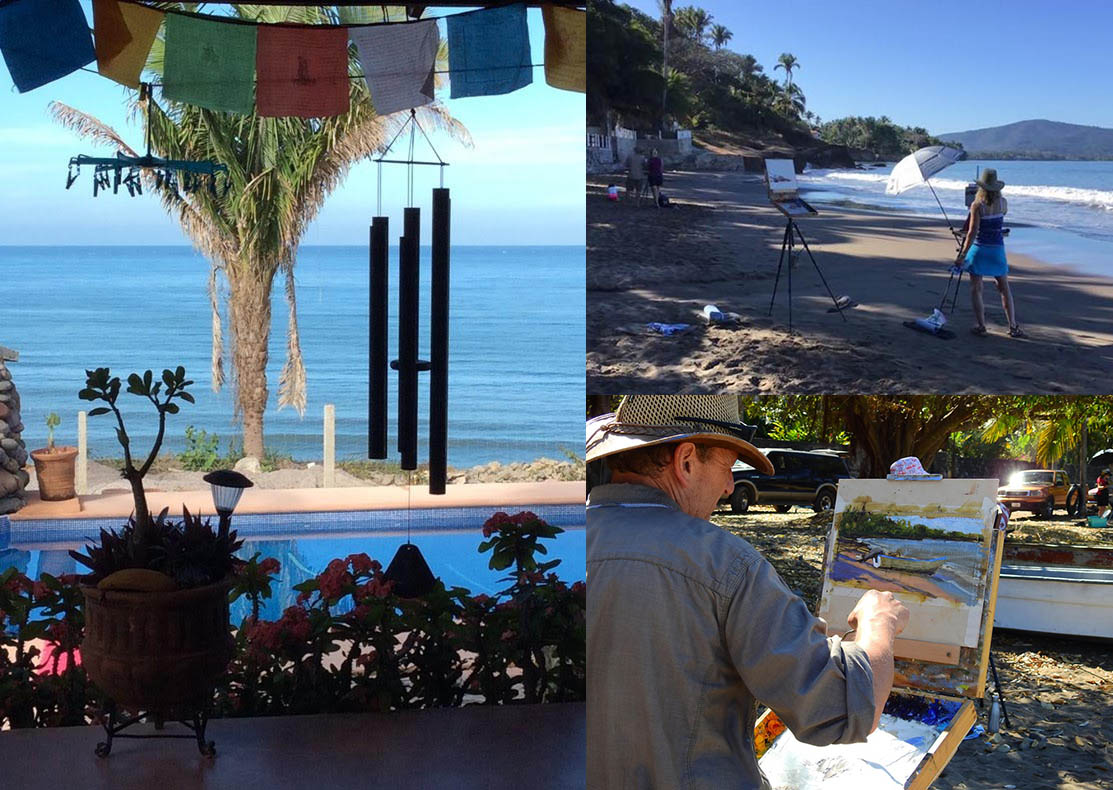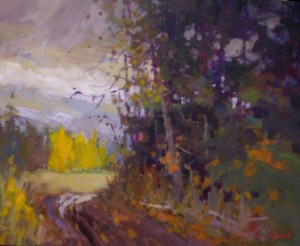Dear Artist,
I was putting the title The Red Canoe on the back of a painting when my friend Joe Blodgett walked in and said, “Nice painting, too bad about the red canoe.”
After a couple of single malts I was looking at the painting through Joe’s eyes. I was pleasant enough when I urged him to go down to the smokehouse to get our smoked salmon, and while he was gone I took off the final varnish and hauled that canoe out of my picture.
Yesterday, a subscriber wrote, “In your last letter you mentioned ‘the principle of paucity.’ What is paucity, and why is it good to have in one’s work?”
Paucity means “the presence of something in small or insufficient quantities or amounts; scarcity.” In our game, it’s one of the main principles. Apart from “His criticism shows a paucity of tact,” or “His resistance to Scotch shows a great deal of paucity,” most significant is the presence of paucity in our work.
“The secret of being a bore is to tell everything,” said Voltaire, and he wasn’t talking about his girlfriend, Emilie du Chatelet. A painting with paucity is one that tells you just enough to arouse your interest — perhaps leading to another excellent word — mystery. Unless the viewer is an engineer, give him too much info and he will yawn and go over to the wine and cheese. In some paintings it’s best to have viewers launch their own canoes.
Overwork, overstate and over-busy are three of the top boo-boos. We come by them honestly — from our innate human desire to give more. Sometimes it takes another person’s eyes to see there’s too much going on. Sometimes it’s painful to remove stuff. But art very often needs lines that disappear, it needs subjects that are suggested rather than told, it needs incomplete areas so viewers can complete for themselves. Our work does not have to be a seamless stream of cleverness.
The same is true in writing. Passages are almost always better when cut back. Writing is rewriting.
We eventually shipped my non-canoe painting. Through the magic of acrylic covering power, nobody knows what’s under there. Somewhere out in the Diaspora there’s a canoeless scene called The Red Canoe.
Best regards,
Robert
PS: “An erasure is a creative mark.” (Melanie Circle) “Remove the noise.” (Leo Babauta) “Understate and overprove.” (Frank Bettger) “Only connect.” (E.M. Forster)
Esoterica: One of Canada’s top cartoonists, Anthony Jenkins, contributes regular caricatures to our national newspaper, The Globe and Mail. In that business, getting a likeness by using only a few brief lines separates the Michelangelos from the Muggses. Jenkins’s frequent touch is to leave out an eye. Yep, he leaves a space where an eye might be. Enough already. Too many strokes and you lose it.
This letter was originally published as “Notes on paucity” on September 2, 2011.
The Letters: Vol. 1 and 2, narrated by Dave Genn, are available for download on Amazon, here. Proceeds of sales contribute to the production of The Painter’s Keys.
“The simplest things are often the truest.” (Richard Bach)
Featured Workshop
If you live in the cold north like I do, this is the BEST thing you can do with a February – believe me! Join me, Hermann Brandt for my 4th annual PLEIN AIR workshop/retreat on the west coast of sunny Mexico. Casa Buena Art Retreat Center is a beautiful private residence overlooking the ocean. While our vivacious hostess, Jane Romanishko takes care of almost every need, I will guide you through the process of identifying, designing, composing and painting the gorgeous land and seascape that surrounds us. Medium: oil or acrylic.
At the end of each day, we gather on the veranda by the pool and critique our work – it’s a beautiful thing :-)
I endeavour to run a friendly, encouraging, no-pressure workshop so beginners are welcome. Minimum of 6 participants. IMPORTANT: Registration by 1 Dec 2019
I look forward to painting with you
Featured Artist
My art represents an artistic journey that has been on-going for more than thirty-five years with help and guidance from many wonderful artists. Now, with years of plein-air painting experience, study and solo exhibitions, I believe that my current work has reached its highest level, reflecting the depth of my absorption in the wonder and beauty of the world around me. I have learned that, as an artist, I will never stop looking for better ways to express my feelings in art and that struggling to more fully understand myself is integral to my painting; a philosophy that was part of every workshop I taught. Still is.









16 Comments
Paucity is a new word for me but one I shall keep close at hand. I often watch people come into my gallery and walk up close to one of my paintings and then move back across the room only to repeat this exchange of viewing places several times. Finally, they will turn to me with this puzzled and delighted express to tell me what I already know. Close up, one only sees loose, sometimes large, patches of colour. But viewed at a distances of 3- 6 feet (distance is dependent on the size of the painting) the landscape is clearly visible, possibly even appearing detailed. The next question is often – how do you do that!? If I understand the meaning correctly, that would be the practice of paucity – only providing just enough of the most essential aspects – just enough shape, gesture of movement, hints of natural light so that it races across the landscape or lingers in the muted greys of an afternoon. That will do it. Only that much is needed. What a great word to capture all of this! Thanks again for yet another inspiring post.
Not sure who said it, but:
If your painting needs something, take something out.
John Singer Sargent was a master at it.
Taking things out can take longer than putting them in – either way it can be a painful process. Oscar Wilde used to meet up with his cronies in the Cafe Royal of an evening when they would discuss what they’d been up to during the day. Someone (perhaps Whistler) asked, ‘What have you been up to today, Oscar?’ To which he replied, ‘I spent all morning taking out a semicolon and all afternoon putting it back in again.’ It does happen.
Augh! Of course!
I like texture in nature and have a hard time controlling how much to put in, and will have to knock some back; but that’s OK, it’s a dance. Oddly, pastels are easier to control than oils, don’t know why; perhaps because it’s more like drawing.
Always good reminders, thanks Sara!
I have struggled over the last week whether to put in an inflatable boat with a person in a red jacket in it in a painting of an Iceberg against a background of contrasting black mountains and white glaciers. In the end I did not perhaps bowing
to the concept of paucity. This happened before reading Robert’s piece on paucity.
Paucity is a very simple requirement in a painting/image.
If it is a single item of focus
it is iconic
otherwise
a painting with more than
3 focuses it is too busy.
Excellent advise. Paucity I need to do more of this.
Learned so much today. Thank you!!
Definitely appreciate the wisdom. But how did he remove the final varnish to get back to the day canoe? Was it on oil or acrylic?
I understand your point of paucity. Very interesting.
Andrew Wyeth said there should always be a ‘sign of life’ in a painting …. a footprint in the snow, tire tracks , etc. The red canoe would have been that sign … just another view
Paucity Pooh….
Save the canoe,
It worked for you!
It’s your talent, your creativity, your vision, your voice….let it speak!
Not all artists are the same.
I’m not a painter because when I look at a tree I see every branch and maybe it’s my mental illness- but if I were going to try and paint that tree I’d be painting every branch. That’s the way MY brain works. And it’s why I am NOT a representational painter.
I’m an abstract artist and always have been. But not an abstract artist that thinks I need to abstract something that’s “real”. I’ve run into artists that think that’s what abstraction means. Load-O-Bull. I’ve had to educate them that for some of us- abstraction means creating something from nothing- not something that is just “something” abstracted. They were like- huh???
The intent behind most of my work is Chaos AND Order. If you can’t even look at my art because your eyes are wildly vibrating because of the juxtaposition of colors- or lines- or shapes- or a black&white palette- then I’ve succeeded. And yes- there are OP ART elements to it. Not 1 red canoe- but hundreds… with some electric blue and lime green canoes thrown in for good measure. Oh I’m sorry. You thought that was a canoe???
So while I appreciate this perspective of leaving things slightly unfinished- that’s NOT what I’m doing. It’s finished- when it’s finished. It has a built structural layer of textiles. Those textile designs may be counted in the hundreds. Or they may be just 1 or 2 different pieces. Once the surface (of possibly 100 different textile designs) has been built- then I look for a different stitch pattern to cover the surface with. Because the piece is layered- that surface work gives the finished piece a relief that casts its own shadow. That shadow play makes the piece change under different light conditions- so the finished piece is different every time you look at it. And the art elements are layered one on top of another.
Not all artists are the same. And we’re not all trying to represent reality- or create the same reality everyone else is.
Some of us create art not to be pretty- but to be beautiful- yet painful. To be disruptive- not peaceful. To not give your eye a place to rest- but to blind you with vertigo. Some of us create art that challenges you. That challenges your perception of reality- rather than reinforcing your stereotypes. Art that does not agree to make you comfortable. Art that earthquakes your foundation. This world is ripe for revolution… and some of us artists are revolutionaries…
Thank you. I am 2yr new self taught and the “paucity” view was making me feel like throwing my hands up and dunking every piece in black gesso to start over. At the same time my gut, my core, my belief that I AM going somewhere was taking me to short-circuitville. I am like you. I am free. I feel in my soul I am going somewhere with the paint. I dont know where & I dont need to and I DONT need anyone telling me what is ‘correct’. Again I must stop listening to ‘out there’. Im new. Never schooled and gd, never want to be. It just constipates me. I feel stuck the last couple weeks & maybe its cuz Im ‘trying’. We shall see. No one has the answer for me. It will reveal when it reveals. You’ve brought me calm for this night. ttyl